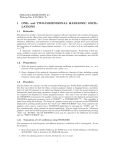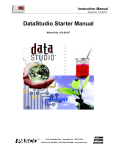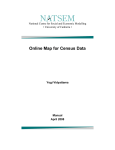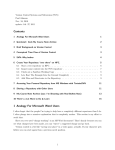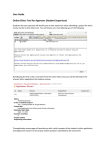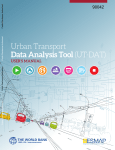Download AUTHOR/APPROVER GUIDE
Transcript
AUTHOR/APPROVER GUIDE Abstract The Author Approver Guide is intended for all participants in the Prioritization Process. It is particularly useful for Authors and Approvers who collectively make up the Author Team. Version 3.0 © Copyright 2014 - Education Metrics, LLC Prioritization Plustm – Author/Approver Guide Contents This Document ........................................................................................................................................................................ 2 Process Calendar ..................................................................................................................................................................... 2 Setup Phase ..................................................................................................................................................................... 2 Training Phase ................................................................................................................................................................. 2 Data Collection Phase ..................................................................................................................................................... 2 Review Phase .................................................................................................................................................................. 2 Analysis Phase ................................................................................................................................................................. 2 Closed .............................................................................................................................................................................. 2 Roles and Assignments ........................................................................................................................................................... 3 Roles .................................................................................................................................................................................... 3 User ................................................................................................................................................................................. 3 Support Team (Institution Administrator Role and Institution Support Role) ............................................................... 3 Task Force ....................................................................................................................................................................... 3 Assignments ........................................................................................................................................................................ 3 Author ............................................................................................................................................................................. 3 Approver ......................................................................................................................................................................... 3 Task Force ....................................................................................................................................................................... 3 Steering Committee ........................................................................................................................................................ 3 Responding to the Questions (Authors or Approvers)............................................................................................................ 3 The Edit Program Information Form ................................................................................................................................... 4 Navigate Like an Outline ................................................................................................................................................. 4 Program /“- none- Program Summary” selected in the Criteria drop down .................................................................. 4 Program/Criterion/“none-Criterion Summary” selected in the Question drop down ................................................... 5 Program/Criterion/Question........................................................................................................................................... 5 Working with the Edit Box ...................................................................................................................................................... 5 Editing Tips .......................................................................................................................................................................... 5 With some limitations you can “Cut and Paste” from MS-Word or other Source ............................................................. 6 Browse Program Information ................................................................................................................................................. 7 Program Write-up Report ....................................................................................................................................................... 9 Approving the Program Write-up (Approver) ....................................................................................................................... 10 Approval is (almost) Final.............................................................................................................................................. 10 Approve the Program Write-up .................................................................................................................................... 10 Glossary ................................................................................................................................................................................. 12 Prioritization Plus™ Author/Approver Guide 3.00 July 17, 2014 Page 1 Prioritization Plustm – Author/Approver Guide This Document This Author/Approver Guide is for all participants in the Program Prioritization Process. It is particularly useful for Authors, Approvers, and members of the Task Force(s). A separate Setup Guide is designed for the first Users of the Prioritization Plustm system who will be getting the software ready for the Data Collection Phase. The Setup Guide will support the Institution Administrators and Institution Support users. Process Calendar At a very high level, Program Prioritization occurs in six phases. Setup Phase During the Setup Phase, your Steering Committee (or Project leadership by some other name) makes numerous decisions about your prioritization project. The most important decisions include writing the criteria by which your programs will be prioritized and the questions that will get to the essence of each criterion. This phase is the subject of the separate Setup Guide. Training Phase Allows access to the system but no ability to “save” work. Data Collection Phase During the Data Collection Phase Authors and Approvers work in the system to answer questions and provide information that is intended to focus on the essence of the various Prioritization Criteria. When complete, the Approver assigned for each program electronically approves the write-up indicating that it fairly and accurately represents the program. Note: Once approved, programs become available to the task force to begin their review. Review Phase During the Review Phase the Task Force reviews the program write-ups and may write comments. They will also assign scores to individual Criterion Question responses or at the Criterion level. Choices: Your institution has made a number of choices about how the system will work. One of those choices is the option to assign scores to either Prioritization Criteria or to Criterion Question, but not both. The Criteria have been assigned weights representing your institution’s values and scores are rolled up to produce a raw program score. Your institution may also have chosen not to do numeric scoring at all. Analysis Phase During the Analysis Phase all information is locked with the exception of tier assignments. The system assigns programs to tiers (quintiles or the grouping designed by your institution) based on scores. Your setup may optionally allow the task force to use judgment to make fine adjustments to the tier assignments when appropriate. Those individuals assigned to writing the final report (typically the Task Force) do their analysis of the findings and write the report and any recommendations. This is not an automated process. The system facilitates the collection and management of your input – but the resulting decisions are not made by software. Closed No further updates are allowed. Prioritization Plus™ Author/Approver Guide 3.00 July 17, 2014 Page 2 Prioritization Plustm – Author/Approver Guide Roles and Assignments You are probably reading this manual because you have one or more of the following roles or assignments. You can have only one Role, but multiple Assignments. Roles User Most participants will be assigned a User role. As a user you can have multiple Author and Approver assignments. You will generally have visibility limited to your own assigned work unless your institution has decided to make completed work more broadly visible. Support Team (Institution Administrator Role and Institution Support Role) The Support Team members will have either the Institution Administrator or Institution Support role. This team will have prepared the system for your use and will be your primary source of training and assistance with system related issues. The Support Team is the only group of people, other than the assigned Authors and Approvers, who can see your work while it is in draft. This is for the purpose of providing assistance as needed. Task Force To be eligible to be assigned to a Task Force, a person must be assigned a Task Force role. Assignments Any person regardless of role may have multiple Assignments. Author Authors are assigned for one or more specific Programs. They are responsible to respond to Criterion Questions that constitute the Program Write-up. A person may be assigned as an Author for multiple Programs and a program may have multiple Authors. All of the Authors assigned to a program plus the program Approver are referred to in this document as the Author Team. Approver Approvers are also Authors and may participate fully with the writing team. In addition, Approvers will review the entire program write-up and approve the final work. This action indicates that the write-up is complete and makes it available to the Task Force for the review and scoring process. There is one approver per program. Task Force The Task Force is the group of people who will be responsible for reviewing all write-ups and scoring according to your institution’s rubrics. To be eligible to be on a task force a person must have a Role of Task Force, Institutional Support, or Institutional Administrator. Steering Committee Your Steering Committee may have a different name at your institution. It is the leadership team that makes the policy decisions about the prioritization process as well as schedule and process decisions. Steering Committee is not an assignment in the software. Responding to the Questions (Authors or Approvers) You can reach the Edit Program Information form from the Program Information Menu. This form is used by Authors and Approvers during the Data Collection Phase. Note: The Data Collection Phase ends for a program when the program write-up is approved by the assigned Approver and the entry is locked and cannot be changed after that point. Prioritization Plus™ Author/Approver Guide 3.00 July 17, 2014 Page 3 Prioritization Plustm – Author/Approver Guide The Edit Program Information Form From the Program Information Menu you can open the Edit Program Information Form. The three drop downs on the top of the page are your means of navigating around the components of a Program WriteUp. The first, the Program Drop Down, will reveal the list of programs for which you are assigned as an Author. Navigate Like an Outline Once you have selected a Program to work on, you can navigate through the list of Criteria and associated Criterion Questions. You can enter write-up text at each “outline” level (Program, Criteria, and Criterion Question). It may be useful to answer the Criterion Questions first and then summarize upward to Criteria and Program. Think as though the three drop down boxes represent an outline. Program /“- none- Program Summary” selected in the Criteria drop down This will be your Program summary text. This section is most likely written last and summarizes your program based on all the detail provided. Prioritization Plus™ Author/Approver Guide 3.00 July 17, 2014 Page 4 Prioritization Plustm – Author/Approver Guide Program/Criterion/“none-Criterion Summary” selected in the Question drop down This will be your Criteria summary text. This section is most likely written after all Criterion Questions have been answered and summarizes the responses to the Criterion Questions. Program/Criterion/Question These are the individual Criterion Question that have been designed by your institution to allow you to provide insight on how well the program meets the associated Criterion. Since you may be working as an Author Team with others the form displays who made the last change. Time is indicated in GMT. Working with the Edit Box The Edit Box allows entry to text as well as a limited amount of formatting. The controls on the top of the box provide a set of formatting options. Editing Tips • • Keep it simple. While formatting options are available, your institution is likely to want to combine these writeups into summary documents. Excessive formatting will detract from your message. [Save] your work. If you leave the page without saving your work it will be lost. Better to save more often. Nothing goes into the database until you press the [Save] button! Prioritization Plus™ Author/Approver Guide 3.00 July 17, 2014 Page 5 Prioritization Plustm – Author/Approver Guide • • Inserting links to external documents or including images may or may not be allowed by your institution. If allowed, follow guidance provided by your institution. Word count limits will be set by your institution. Write succinctly to make your points. With some limitations you can “Cut and Paste” from MS-Word or other Source Many people will choose to work outside of the system and then paste the results into the Program Information Form editor box. You can paste text from other sources, especially Microsoft WORD, but be aware of some limitations. • • • • Prioritization Plus™ limits the formatting allowed in order to give a consistent look and readability across all of the write-ups. o Font changes are not allowed in order to maintain a consistent look. o Tables are not allowed because you can enter table data separately in a way that allows the institution to download tables as data. o Images can’t be “pasted” into a document although they can be added from within the editor if your institution allows images. o Numerous HTML formats (such as Forms and iFrame) are not allowed because they could create a security problem or because the reporting tools do not support them. Prioritization Plus™ does support: o Bold, Italic, Underline. o Bullet Lists or Numbered Lists (from MS-Word). o Heading 1, Heading 2 and Heading 3 styles (from MS-Word). Prioritization Plus™ will attempt to remove formatting that is not supported. o Most Microsoft WORD text will be “cleaned up” at the moment you paste it. o Review as you paste to be sure you are getting what you expected and make any necessary modifications within the Prioritization Plus™ editor. o Some removal of unsupported formatting will happen when you save your work. If you have pasted text it is a good idea to look over your text after you save in case you need to make any manual changes. Text pasted from sources other than Microsoft Word may be less reliable. o Paste from MS-Excel is not supported. (Tables are not supported in the text). o Text pasted from other sources may not be checked as completely. Be sure you are only pasting supported formatting and double check the formatting after you save. Prioritization Plus™ Author/Approver Guide 3.00 July 17, 2014 Page 6 Prioritization Plustm – Author/Approver Guide Browse Program Information One challenge of the Edit Program Information form is that you see the write-up one component at a time. It is a little harder to view and review the entire write-up. The Browse Program Information form is designed to solve that problem. It displays the entire write-up in an expandable outline view. The initial display shows the Program Summary text as well as each criterion summary. By clicking on any + sign by the criterion or by selecting “Expand All” you can see the complete write-up including all question responses. Prioritization Plus™ Author/Approver Guide 3.00 July 17, 2014 Page 7 Prioritization Plustm – Author/Approver Guide Clicking on an Edit Icon on the right will take you directly to the Edit Program Information form for that specific element. This is especially useful for final editing of the write-up. Prioritization Plus™ Author/Approver Guide 3.00 July 17, 2014 Page 8 Prioritization Plustm – Author/Approver Guide Program Write-up Report From the Report menu, Authors and Approvers can run the Program Write-Up report on their assigned program. Prior to approval, they will be labeled “Draft”. Prioritization Plus™ Author/Approver Guide 3.00 July 17, 2014 Page 9 Prioritization Plustm – Author/Approver Guide Approving the Program Write-up (Approver) As an Approver you are also a member of the Author Team but you have the additional responsibility of determining when the writing is done. You do this by approving the program write-up. Approval is (almost) Final It is best to have reviewed the entire write-up content before approving a write-up. It can be undone, but you cannot do it yourself. To retract an approval a Task Force member must agree to remove your approval so you can continue to revise text. In that case, you must approve the program write-up again when you are complete. Note: Your Steering Committee may set deadlines and is able to approve your write-up for you when deadlines have passed if the Approver has not done so. Please be aware of your institution’s project schedule and policies. Approve the Program Write-up Approval is at the program level which means you are approving the entire write-up including Program summary, all Criteria summaries, and all Criterion Question responses. Note: If your institution has chosen to enable “Proposed Scores” as an Approver you can suggest scores. Your proposed scores (at either question or criterion level) will be used as input advice to the Task Force but will not be included in the final scoring. It will, however, enable you to highlight differences between programs for which you are responsible. The scoring control will be at either the Criteria level or the Question level depending on your institution’s setup options. The Proposed Score drop-down will be next to the [Save] button at the appropriate level. Select the appropriate score and then [Save] To approve the write-up, navigate to the program summary level by setting the Criteria drop down to “none – Program Summary” and select the [Approve Program Write-Up] button. You will be presented with a confirmation form that will list every component of the program write-up. You can proceed to [Approve Program Write-Up] at the bottom of the form or [Cancel] at this point. Prioritization Plus™ Author/Approver Guide 3.00 July 17, 2014 Page 10 Prioritization Plustm – Author/Approver Guide Note: An Approver can use this form to check the status of the write-up work at any time. Just be sure not to confirm by pressing [Approve Program Write-Up] until you are ready. Prioritization Plus™ Author/Approver Guide 3.00 July 17, 2014 Page 11 Prioritization Plustm – Author/Approver Guide Glossary Approver An Approver has final approval for a program write-up and marks the write-up as complete. The approver also has Author access and can participate actively on the team with the authors for the program. Author A User who is assigned the responsibility for preparing the program write-ups for one or more programs. Any User can be assigned to an author role. If multiple authors are assigned to the same program they should be prepared to work together on the write-up because only one write-up will represent the Author Team. Criteria The standards or benchmarks by which programs will be evaluated and prioritized. Information related to a Criterion is gathered through the answers to one or more Criterion Questions that are designed to highlight performance against the Criterion. Criterion Question “Department” Institution Administrator The Criteria Questions are the specific requests for information related to a criterion that will guide the authors. Well-chosen and written questions will improve the quality of responses and shed the light you need on how well a program meets the specified criterion. Default questions are provided for the default Criteria but it is not intended or recommended that you use all of these. A small number of carefully chosen questions will be most successful. A “department” is the organizational unit to which programs are assigned. In the User manual “department” is in quotes because its actual label in the system can be modified to meet your needs on the Labels form. The Institution Administrator is a User with the highest level of system privilege for the institution. The Institution Administrator can do any of the functions of Institution Support plus the following: - Change the Process Calendar Phase - Edit Criteria, Questions or Scoring options after the Data Collection Phase has begun. Of course, making any of these changes after the Data Collection Phase has begun is not recommended. Institution Support Institution Support Users have most system privileges necessary to setup and operate Prioritization Plustm including the ability to add Users, grant privileges, and perform most activities during the Setup Phase. Prioritization Criteria The set of Criteria by which programs are prioritized is central to how your institutional values and strategy are reflected. The set of criteria recommended in Prioritizing Academic Programs is provided and can be loaded by default. Although the default weights are set to be equal, you will want to be thoughtful about your final selection and wording of Criteria as well as the relative weighting given to each Criterion. Program Type Where it makes sense for different groups of programs to be prioritized using different sets or Criteria and optionally, by different task forces, a separate Program Type is used. Most institutions use only two types of Programs, “Academic” and “Non-Academic” each with their own set of criteria. Prioritization Plus™ Author/Approver Guide 3.00 July 17, 2014 Page 12 Prioritization Plustm – Author/Approver Guide Program Most simply stated, a program is any activity undertaken by your institution that consumes resources. It is the unit of analysis of the prioritization project. “School” A “School” is the higher organizational unit to which “departments” are assigned. In the Prioritization Plustm documents, “school” is in quotes because it is a label in the system that can be modified to meet your needs on the Institution Setup | Labels form. Steering Committee The group of individuals assigned to design and oversee the entire program prioritization process. They will make most of the setup decisions and have a high level of responsibility for the success of the project. Task Force A team of representative and strategic thinking individuals who will be responsible for reviewing all the program write-ups, providing useful comments and assigning a score to criteria or questions depending on the scoring options. User The term user has two meanings depending on context. Most generally it refers to any person with access to Prioritization Plustm by means of a Username and password. However, when distinguishing Users by role, a User is any person who is not in an Institution Administrator, Institution Support or Task Force role. Users may be assigned Author, Approver, or Task Force responsibilities. User Role The User may have one of four roles assigned. Most Users have a role of “User.” Users will receive additional privileges and access dependent on their assignments as Author, Approver, or Task Force member. A few Users will be assigned the role of Institution Support, Institution Administrator, or Task Force. Prioritization Plus™ Author/Approver Guide 3.00 July 17, 2014 Page 13














